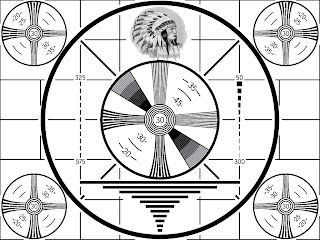Sent to The Frederick Leader and The Frederick Press, September 27, 2011
 |
| Family watches TV in the 1950s (Source: National Archives and Records Administration, via Wikipedia Commons) |
Television was new in 1953
In early 1953, the world of entertainment changed permanently for the people of Tillman County when area TV stations started broadcasting. Television had arrived.
Channel 6 in Wichita Falls, KWFT-TV, took to the air on March 1, 1953, carrying CBS and DuMont programming. Channel 7, KSWO-TV in Lawton, started broadcasting one week later on March 8, 1953, and KFDX Channel 3 in Wichita Falls went on-air April 12, 1953.
 |
| TV from the early 1950s |
Each station’s programming was a mixture of network shows and shows that originated at the local station. Many of the national and local shows were broadcast live.
Tillman County residents who owned a TV and a good antennae had access to the three new area channels, although reception varied by location.
One Oklahoma City station, WKY, had been on the air as early as 1949, and some residents had been able to pick up weak fuzzy reception from the WKY broadcasts.
The first issue of TV Guide Magazine was printed on April 3, 1953, with Lucille Ball and baby Desi Arnaz, Jr. on the cover.
Within a few years, many people had purchased television sets – a significant investment for the time.
 |
| Crosley TV set ad, 1953 |
Nationally, the average annual income in 1953 was $4,011. Base-model table-top TVs started at about $200, but most sets were more. Zenith advertised its 27-inch black-and-white Canterbury cabinet model for $750.
By 1954, The Frederick Leader printed weekly listings of programming for area stations Channels 3, 6, and 7.
Those listings were quite popular but did not take a large amount of newspaper space because in 1954 TV stations broadcast only part of each day. On weekdays each station went on-air in the early-to-mid afternoon and signed off by 10:30 p.m. at night. On Saturdays the stations went on-air mid-to-late morning with programming for children. Saturday shows included “Howdy Doody”, “Superman”, “Winky-Dink and You”, and “Bobo the Hobo”.
Sundays were reserved primarily for TV church services, sermons and devotionals.
What was on during the rest of the week? The Frederick Leader’s TV Listings from May 1954 showed a variety of programs.
Channel 3’s NBC daily weekday programming began at 1:00 p.m. and included “The Kate Smith Hour” and “The Pinky Lee Show”.
Afternoon programs that originated at Channel 3’s station included “The Nat Fleming Show” and “Horse Opery Matinee”.
 |
| Admiral TV, 1953 |
Channel 7 signed on at 3:00 p.m. on weekdays with a matinee movie, followed by “Kids’ Corner” and “Tales of the West”.
Channel 6 afternoon programs featured soap operas such as “Woman With a Past”, “Sands of Time” and “The Secret Storm”.
News and weather reports were brief. Channel 3 featured “News of the Day”, a five-minute newscast at 6:00 p.m., followed by “Warren and the Weather” (with longtime Channel 3 personality Warren Silver) which was a five-minute weather forecast.
News and weather on Channel 6 occupied a 15-minute block from 5:45-6:00 p.m. At Channel 7 a 30-minute period from 6:30-7:00 p.m. was devoted in equal parts to news, weather and sports.
As today, most featured programming was in the evening. Some of the shows that aired in spring 1954 were the following: “Milton Berle” (NBC); “The Red Buttons Show” (CBS); “Liberace” (ABC); “You are There” (CBS); “Life With Father” (CBS); “The Loretta Young Show” (CBS); and “The Cisco Kid” (ABC).
 |
| The "Off-Air" test pattern was a common site in the 1950s. |
Other shows were “The Dennis Day Show” (NBC); “Name That Tune” (NBC); “Mr. Wizard” (NBC); “Joe Palooka” (CBS); “Blue Ribbon Fights” (CBS); “Life of Riley” (NBC); “Amos & Andy” (CBS); “Your Hit Parade” (NBC); “The Paul Winchell Show” (NBC); “Burns and Allen” (CBS); and “I Love Lucy” (CBS).
All of the stations had a 15-20 minute block for news and weather updates at 10:00 p.m. before signing off for the night.
 |
| Zenith magazine ad, 1953 |
No comments:
Post a Comment